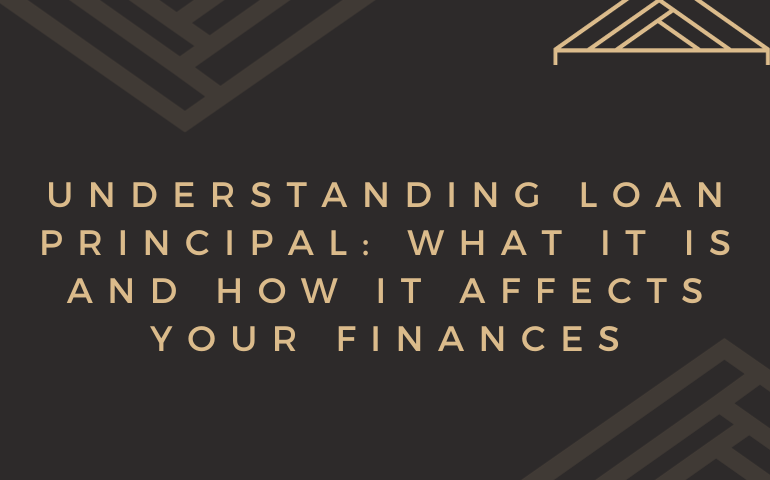
Mortgage Dove
Understanding Loan Principal: What It Is and How It Affects Your Finances
Want to know what loan principal means? It's the original amount you borrow and need to pay back. Check out how it works, why it matters when buying a home, and why your monthly payments may not hit the principal immediately. When you borrow money, the loan principal is the original amount you borrowed and need to pay back. You might also have to cover interest and fees until you've paid off the total borrowed amount. Example of Loan Principal Imagine this scenario: You borrow $10,000 to buy equipment for your business and pay $2,000 upfront. So, you're left with an initial loan amount of $8,000. The bank charges a 4% yearly interest rate. Next month, your principal stays at $8,000, but you'll owe an extra $27 in interest ($8,000 x 4% / 12). You decide to make a $500 payment. Out of this, $27 covers the interest, and the remaining $473 reduces the principal. After the payment, your loan amount drops to $7,527. When the bank calculates your monthly payments, they spread out the loan over time, making a schedule that shows how it impacts your finances. This schedule details how long it'll take to pay off the principal and how much each monthly payment goes towards interest or principal. With big loans like this, most of your monthly payments initially tackle the interest rather than the principal. Since your principal is high, you end up owing more interest. However, as you keep making monthly payments, the principal decreases, and interest charges drop. This means more of your regular payments start reducing the principal amount. Your monthly statement breaks down how your payment is divided in detail. Interest is what you pay to borrow money, while the principal is the actual amount you borrowed. Initially, most of your monthly payments cover the interest rather than reducing the borrowed amount due to a process called amortization, which spreads out loan payments over time. With big loans, at the start, more of your monthly payment chips away at the interest rather than the principal because the interest owed is higher when the borrowed amount is larger. As you keep paying monthly, the principal decreases, causing less interest to be charged, and more of your payment reduces the borrowed amount. Your monthly statement breaks down how your payment is divided. Toward the end of the loan, most of your payment goes into reducing the principal. An amortization schedule outlines how much of your monthly payment tackles the principal and how much covers interest. For instance, in a mortgage scenario, at the last month of repayment, $2 goes to interest, and $841 goes towards reducing the principal. Note: If you want to pay off your loan quicker, try making extra payments directly towards the main amount you owe. Before that, check if your lender charges a fee for paying early. This fee is also called a prepayment penalty. Knowing this will help you plan and avoid unexpected charges. You usually find loan principal in loans where you pay back the money with regular monthly or scheduled payments over a set time, like five or 30 years. These loans can include stuff like: Your loan principal is listed in your initial loan papers and monthly statements. If you can't see it clearly, ask your lender. For a home loan, check page one of your bank's closing disclosure for your total loan amount, interest payment, and monthly principal plus interest. For student loans, find your loan principal in the initial disclosure statement, exit-counseling docs, and your billing statements. With a personal loan, you can spot your loan principal in your monthly statement or online account. The loan balance is the total amount you owe on your debt, including the original amount borrowed (principal) and any added interest, like with certain student loans that gather interest daily. The payoff amount might not match your balance or initial loan principal because of extra costs like prepayment penalties or fees. Even if you borrowed $200,000 initially, your current balance could be higher due to interest, insurance, and property taxes. As you make monthly payments, your loan balance will shrink over time. Loan interest payments, such as mortgage and student loan interest, may be tax-deductible for individual taxpayers. However, payments toward the loan principal are not eligible for tax deductions. Regarding businesses, the principal payment amount of a business loan is part of the overall cost for an asset like a company car or building. This total cost, termed as the cost basis, covers down payments, acquisition expenses, and initial costs. Businesses can spread out this cost (depreciate) over the asset's lifespan, gaining tax deductions over that period. Additionally, businesses can deduct interest expenses annually, albeit with certain restrictions. What Is the Principal Loan Amount? The principal loan amount is just the money you borrow first from a lender. It doesn't count any extra fees or interest the lender adds, and it doesn't cover upfront payments like a house or car down payment. Is Principal the Same as Loan Balance? Principal and loan balances aren't identical, but they're connected. The principal is the original sum you borrowed from a lender when you got the loan. On the other hand, the loan balance is how much you still owe at any moment, considering payments that lowered the principal and any fees or interest that got added. Understanding loan principal is crucial for anyone borrowing money. It represents the initial amount borrowed and impacts monthly payments significantly. Initially, most payments go towards interest, with a smaller portion reducing the principal. Over time, more goes towards paying off the principal. It is essential to identify the principal on loan statements and understand its impact on taxes.What's a Loan Principal?
What's the Difference Between Principal and Interest?
Where to Expect Loan Principal
How to Identify Your Loan Principal
Loan Principal vs. Loan Balance
Loan Principal and Taxes
Frequently Asked Questions (FAQs)
The Bottom Line
"Mortgage Dove makes home financing convenient for every American. You can count on us to provide a home buying experience tailored to your personal needs and financial situation. We strive to give you the peace of mind that your home financing goals can be achieved.”

Mortgage®
www.mortgagedove.com



-and-how-does-it-work.png)